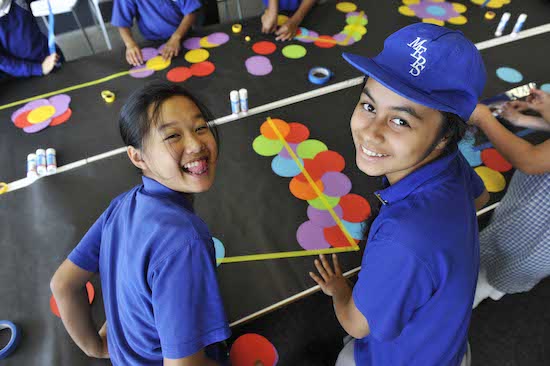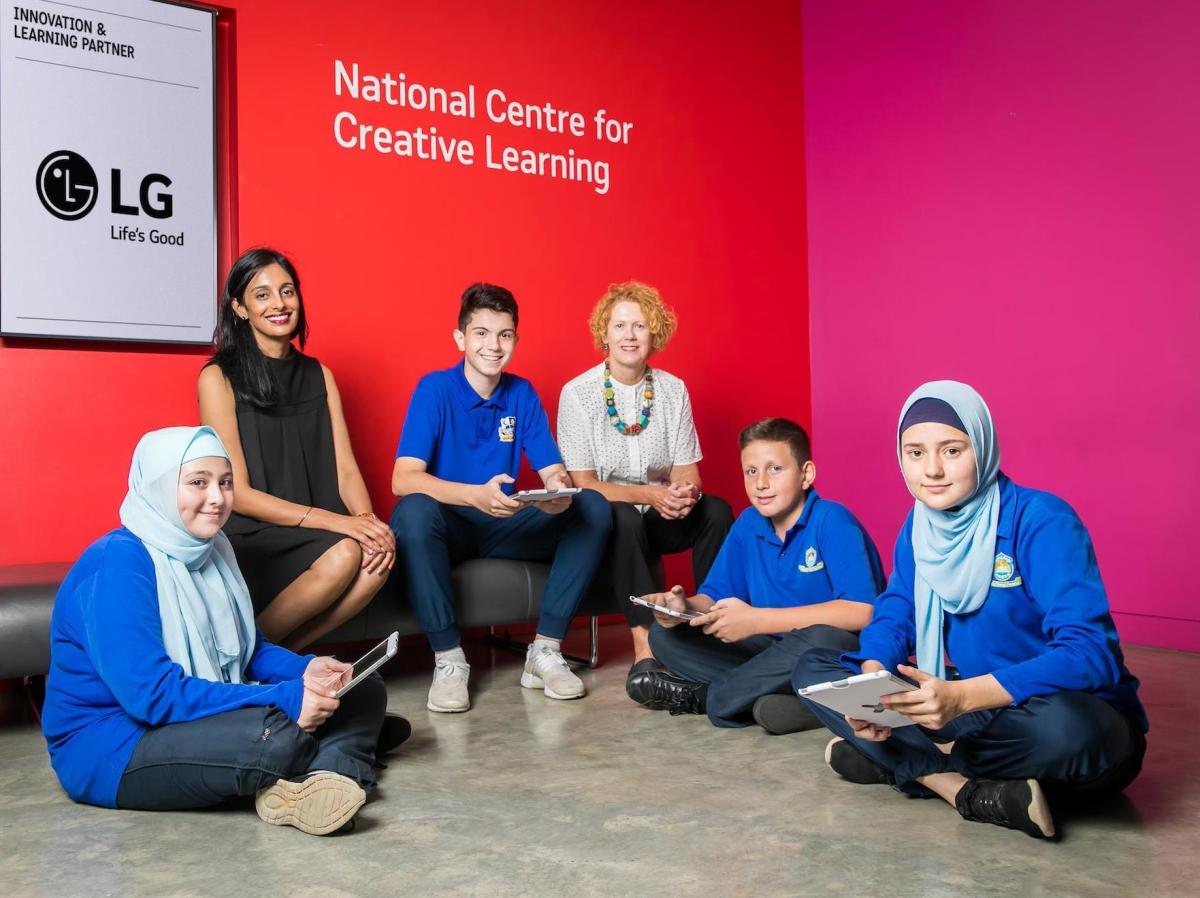Image: Ifran College students, MCA Director and LG Head of Corporate Partnerships. Supplied.
Three years ago, Merrylands East Primary School – a public school in Sydney’s South West where 10% of children are from refugee families and nine in 10 students come from a non-English speaking background – was organising a Canberra excursion for students.
The visit included transport from Merrylands and visits to Parliament House and the National Gallery of Australia. But for many families, the trip was too expensive and children were missing out.
‘Our trip to Canberra would cost a couple of hundred dollars and many of our children couldn’t afford to go,’ explained Merrylands East Principal John Goh.
‘We looked at alternatives for those who couldn’t afford to go to Canberra and one was a visit to the Museum of Contemporary Art (MCA) and Parliament House in Sydney. In order to do that, we knew we had to pay for students to attend lessons at the MCA and so the teachers and myself actually paid for the children to attend.’
Merrylands East’s visit to the MCA became a catalyst for improving access and affordability for many of the young people living in Western Sydney today. After listening to Goh talk about the issue of affordable access to Australia’s cultural institutions, the Creative Learning team at the MCA developed the MCA Together: School Access Program.
The program is part of the MCA’s world-class National Centre for Creative Learning and provides a subsidy to improve access for public schools in Western and South West Sydney.

MCA school program, Merrylands East Primary, 2014. Photo Adam Hollingworth. Image supplied.
It is timely intervention, especially given the important role creative thinking plays in tackling the opportunities and challenges of 21st century, as well as issues of access compounded by migration and the changing cultural makeup of Greater Western Sydney.
Georgia Close, Manager of Student and Teacher Engagement at the MCA, said: ‘For a lot of the children who come with their school, very often they are coming to the museum – not only to our museum, but to any museum – for the first time. Often they are coming to the city for the first time as well.
‘It is a really fabulous program and we work with children from refugee backgrounds and newly arrived families,’ she added.
The program’s design is innovative and seeks to teach creative thinking while also breaking down existing barriers to cultural institutions like the MCA. Children who participate in the four day program are asked to write a resume and apply for a job at the MCA, where they attend an interview before joining as a junior team member. Students are also provided with an Opal card and learn how to travel to and from the city, which for many of them is their first trip outside their local areas.
While the MCA Together program started with Merrylands East Primary, today the MCA works closely with a number of schools. ‘The children work with our artist educators to deliver their own projects about the museum. Over the course of those four days, they develop a learning program for their families, so they take on the role of the artist educator and deliver their own experience for their family to support them to connect with contemporary art,’ said Close.
Artists make the best teachers
MCA Together isn’t the only learning program available – the Museum runs a suite of them, involving over 20,000 school students and teachers annually.
Such programs include the introductory Creative Guide to Contemporary Art for primary and secondary students, as well as the Bella Program, which started in 1993 and provides free creative learning programs for students with a disability or access requirements.
All programs are participatory and learner-centred experiences, where students are encouraged to connect with contemporary art and artists, as well as each other, on a personal level.
‘We don’t give tours. We use what we call creative learning strategies, which are about supporting students to find their own connection to an artwork and generate their own meaning in a group setting,’ explained Close.
The MCA blends creative learning and experiential environments to deliver these hands-on programs that encourage creative thinking in action; a cornerstone to this approach are the Artist Educators.
‘Artistic practice is the perfect model for creative learning. All the ingredients that go into being an artist – risk taking, experimentation, working with materials, thinking creatively and critically – all those ingredients are the same essential ingredients needed to support creative learning.
‘Across the whole museum we recognise that artists are people who can help us to see the world differently, and so having artists devising learning experiences is really key to what we do.’
In 2017 the MCA introduced two new Aboriginal and Torres Strait Islander programs, which are guided by an Indigenous Cultural Learning framework. The Winangali student workshop is designed for students and is supported by the MCA’s extensive collection of contemporary First Nations work. A second program, the Namuru Teacher Professional Development workshop, is designed specifically for educators and has proven hugely popular, booking out weeks in advance.
‘Lots of teachers say they want to engage with the work of Aboriginal and Torres Strait Islander artists but for a lot of non-Indigenous teachers, there is a real fear around wanting to do it the right way but not knowing how and then some end up not doing it at all. We’re working really hard to address that through these types of programs,’ said Close.
Inaugural Major Partner for Innovation and Learning
This year the MCA has welcomed LG Electronics as the new Major Partner for Innovation and Learning. The multi-year partnership is valued at over $1 million and will enable the MCA to continue delivering its learning programs for students and teachers across Australia.
Parvinder Gill, Corporate Marketing Manager at LG Electonics said: ‘I’m really excited about this partnership and the alignment with the National Centre of Creative Learning. From a brand fit, a company fit, education is about life, school and innovation. But also from a personal perspective and having a young kid, seeing the impact art has on them in nurturing a sense of imagination, it is like time slows down when they are immersed in the act of creating.’
Gill said ‘creativity is so important’ in the context of innovation and technological development.
‘From our perspective as a company based out in Western Sydney, we would love to see more schools have access to this program; kids that would never get a chance to come into the city and have that exposure. I know personally, my parents migrated here from Malaysia and their qualifications weren’t recognised in Australia. They had three of us kids and were working full time studying. We really didn’t have the opportunity to go out for the day, to go into the city and see that. I would love more young kids to have that life-changing access.’
Visit mca.com.au/learn/schools find out more about MCA school programs.





